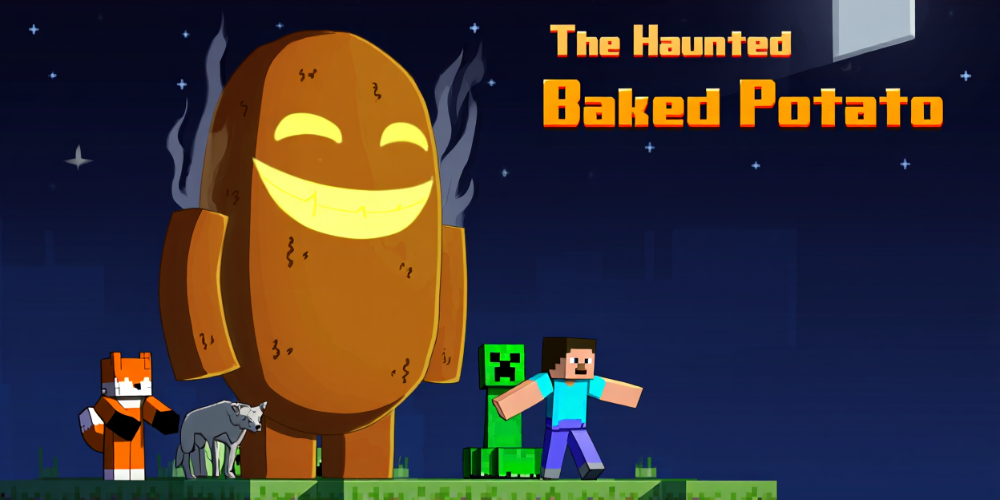
Minecraft’s latest Marketplace spotlight leans delightfully weird: The Haunted Baked Potato. It’s a playful, seasonally spooky mash‑up that treats the Overworld like a haunted stage set—light scares, big laughs, and the kind of environmental gags that make you nudge a friend and say, “Did you see that?” As with most mash‑ups, expect a curated world, custom resource pack, and a self-contained adventure loop that’s easy to start and satisfying to finish in a single evening or a weekend with friends. The official Minecraft.net page you shared is your source of truth for creator credits, pricing in Minecoins or local currency, supported languages, and any bonus skins. Below, you’ll find a clear plan: how to install it cleanly, how to get the most out of its haunted-comedy vibe, and the small settings tweaks that keep the experience smooth and readable on consoles, PCs, and mobile.
How to get and install the mash‑up
- Open Minecraft Bedrock (Console, Windows, Mobile) and visit Marketplace. Search “The Haunted Baked Potato.”
- Review the listing: read the description, check screenshots, supported player count, and required storage. Confirm any included skins or music packs.
- Purchase or redeem, then select Create this World (or Download first). The template appears in your Worlds list.
- Launch from the template; it will auto-apply the required resource/behavior packs. If prompted, accept “Require players to accept resource packs” so everyone sees the intended art and audio.
- For co‑op, invite friends from the pause menu after the world loads. Everyone should run the same build version for clean syncing.
What’s inside and how it plays
Mash‑ups like this are built around guided exploration, dialogue beats, and a handful of puzzles or mini-objectives that escalate without demanding expert combat. The comedy comes from surprise interactions—doors with opinions, potatoes with personality, and set pieces that riff on familiar Minecraft mishaps. Progress typically flows via waypoints, quest items, and environmental clues (signs, notes, oddly placed blocks) rather than open-ended crafting. The fun is in looking closely: push suspicious buttons, check basements, and circle back to previously locked rooms after a story beat. If the map includes custom mobs or bosses, expect fair tells and arenas designed to showcase the resource pack’s sightlines, not overwhelm you. Plan for session-friendly chunks: one or two chapters per night, with natural stopping points after each big gag or reveal.
Co‑op etiquette and settings for a clean run
- Follow the rules at spawn. Many creator maps disable breaking/block placing in key zones to protect scripting—respect that to avoid scuffing triggers.
- Stick to the recommended player count from the listing or in‑world book. Overfilling can desync dialogue or puzzle logic.
- Enable subtitles in Accessibility for audio cues, and bump Brightness slightly if you’re on a dim panel; the art leans moody but stays readable with good contrast.
- Set Simulation Distance to a moderate value so redstone and mobs behind walls tick consistently without overloading low-end devices.
- Voice chat or a quick group call helps for code-sharing and split-search moments. Elect a note‑taker to track keypad hints and item locations.
Tips to find secrets and avoid softlocks
- Read every sign, book, and clue. Creator maps love punny hints that double as directions.
- Keep one hotbar slot free for quest items; don’t stash them in shulkers unless the map explicitly allows it.
- If you think you’ve missed a key, retrace “hub” rooms. These maps often unlock previously quiet corners after a story beat.
- Take screenshots of codes or peculiar symbols; some jokes are also puzzles that pay off 20 minutes later.
- Before a suspected boss or set piece, reduce music volume slightly so you can hear effect cues and NPC lines clearly.
Performance and accessibility notes
- Lower particles and fancy leaves on mobile to keep frame pacing smooth during effect-heavy gags.
- If motion sensitivity is a concern, reduce FOV a notch and disable screen shake (where supported).
- Colorblind-friendly play: raise contrast via your display or the game’s accessibility slider; many puzzle elements rely on shape and iconography in addition to color.
- On split-screen consoles, increase UI scale and safe-zone padding so subtitles and quest text don’t hug the bezel.
Parents, educators, and creators
The Haunted Baked Potato hits the sweet spot for family sessions: comedic tension, approachable puzzles, and a clear arc you can finish together. Turn it into a mini “read–play–build” club: read clues aloud, play a chapter, then hop into your main world to recreate a favorite room or gag with standard blocks. For streamers and community hosts, this mash‑up is perfect for themed nights—no mods needed, clean onboarding, and plenty of screenshotable moments. If you’re a budding creator, treat it as a study piece: note how lighting guides you, how item gating keeps momentum, and how jokes double as tutorials without big text dumps.
Conclusion
If your spooky season needs more whimsy than dread, The Haunted Baked Potato is the right flavor—comfortably eerie, puzzle-forward, and shareable with friends across Bedrock devices. Grab it from Marketplace, keep the resource pack enabled, stick to the recommended player count, and savor the small surprises tucked behind every creaky door. For exact pricing, regions, and any bundled cosmetics, rely on the official announcement you shared; then set aside an evening, warm up your screenshot key, and let a very opinionated potato lead you through a cozy haunted romp.